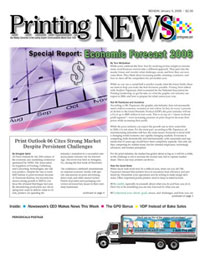|
  Jan. 9, 2006—While some celebrate the New Year by resolving to lose weight
or exercise more, most business owners take a different approach. They peer into
the murky future
and wonder what challenges await, and how they can overcome them. They think
about increasing profits, retaining customers, and how to stave off the competition
for yet another year. Jan. 9, 2006—While some celebrate the New Year by resolving to lose weight
or exercise more, most business owners take a different approach. They peer into
the murky future
and wonder what challenges await, and how they can overcome them. They think
about increasing profits, retaining customers, and how to stave off the competition
for yet another year.
While no one has a crystal ball to predict exactly what
the future holds, there are tools to help you make the best decisions possible.
Printing News talked with
Andrew Paparozzi, chief economist for the National Association for Printing Leadership,
to get his take on what the graphic arts industry can expect in 2006, and how
to prepare for what comes your way.
Not All Rainbows and Sunshine
According to Mr. Paparozzi, the graphic arts industry
does not necessarily need a full-on economic recession to feel a blow. In fact,
for every 1 percent of decline
in the Gross Domestic Product (GDP), the print industry will see a hit of up to
$800 million in lost work. This is on top of a ?classic textbook profit squeeze??ever-increasing
pressure on print shops to decrease their prices while increasing their profit.
While
the print industry can expect the growth rate to slow somewhat in 2006, it is
not alone. For the most part, according to Mr. Paparozzi, all manufacturing
industries will face the same issues. Everyone is faced with a changing world
economy and rapidly changing markets. Everyone is competing, both domestically
and internationally,
with companies and segments that 10 years ago would have been completely separate.
Not only are they competing for market share, but for talented employees, technology
advances, and market perception.
For the print industry, the market has gotten
about as big as it will for a while, so the challenge is not to increase the
market size, but to capture market share.
This is one way printers can thrive.
Now the Good News
When faced with what may be a difficult year, what can you do?
Mr. Paparozzi stressed that printers have to maximize their efficiency and productivity.
Streamline your
operations and be willing to make tough decisions. Other important points printers
need to keep in mind include:
- Be candid, especially to yourself, about what you
do and how you do it. Don?t
try to be something you are not, but excel in what you are.
- Understand your clients? goals, issues, and challenges, and how you can
create value for them. Realize that you are in the communications business, not
the ink-on-paper business, and be ready to make a compelling case for why a client
should work with you.
- Know your competition; know who you are competing against and where they
are coming from. Your biggest competition may not be the shop down the street,
but
the shop across the country.
- Candidly and soberly look at your operations. There are no easy answers,
but one way to do this is to build a seamless digital workflow.
The most fundamental
change you need to be aware of is that the industry is moving away from being
technology-driven, to being leadership and management-driven. Everything
is getting more complex; every decision carries more risks and greater potential
rewards. More than ever, print shops need people in charge with the skills to
balance these factors and guide them forward.
?The one thing you cannot do is ignore this,? commented Mr. Paparozzi. ?You
cannot assume that [industry changes] will not happen tomorrow.?
Keep an Eye Out
Some trends driving the changes can be anticipated. One is the increasingly
global economy. China, said Mr. Paparozzi, will continue to grow as a print competitor,
and is likely to have a significant impact on the U.S. print industry in 2006.
Other areas printers should keep an eye on include Latin and South America, which
both have growing graphic arts industries.
Another trend that many printers worry
about is the Internet and the digitization of communication. However, we do not
communicate in just one way, and long term
this is an opportunity, not a threat. The key here is providing solutions.
Printers
must be willing to become partners with clients and offer suggestions for the
most effective way to get the message out. This could be print, it might
be the Internet, or it may be something else. Those shops willing to turn potential
threats into opportunities will be the ones who come out ahead.
The industry is changing, of that there can be no doubt. Everyone who participates in graphic
arts, from printers to designers to trade shops, will have to create their own growth and find their own market niches. The single biggest threat the industry faces is complacency, noted Mr. Paparozzi. Figure out how to differentiate yourself and how you can become a valued asset to your clients, and 2006 will be a year of great growth and prosperity.
|


